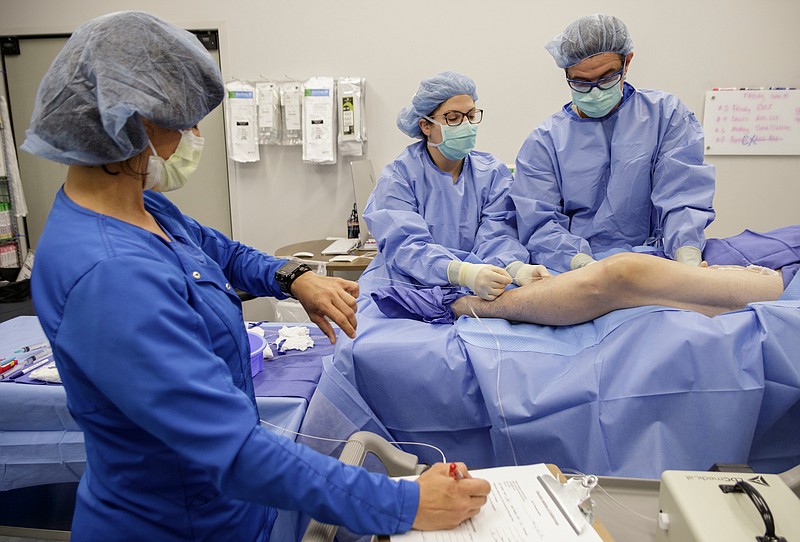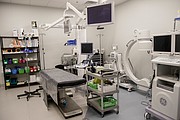Watch for:
Feeling of painLoss of sensationOpen sores that won’t healWeakness when walkingSource: Vascular Institute of Chattanooga
Blood transports oxygen, and if the flow to a major organ like the heart or brain stops, the outcome can be deadly. But Dr. Chris LeSar says poor circulation to other body parts, such as the lower limbs, also is a serious problem, yet often overlooked.
"Everyone knows about heart problems, and they know about stroke problems - we just don't talk so much about leg problems," said LeSar, a surgeon and founder of the Vascular Institute of Chattanooga, which treats circulatory failure and blood vessel diseases.
LeSar is on a mission to educate people about peripheral artery disease, or PAD, the narrowing or blockage of the vessels that carry blood to extremities. Most often PAD happens in the legs, since they're farthest from the heart and the blood vessels are smaller. The longer circulation is slowed or stopped, the more likely tissue will die and require amputation.
The primary symptom of PAD is leg pain and cramping while walking, although some people don't experience pain. Loss of sensation, weakness and wounds that won't heal are other symptoms.
Critical limb ischemia, a severe obstruction of the arteries that drastically reduces blood flow to the limbs, is one of the leading causes of amputation, and the Southeast has the highest amputation rates in the country. Many of these surgeries could have been prevented with proper education and alternative treatment plans, according to LeSar.
"We have to drive awareness that if you have those problems, you've got to get evaluated and quickly. It's not something you can wait on," LeSar said. "It's so prevalent that a lot of doctors and patients don't deal with it until it turns black and ready to fall off, and that's when it's too late."
About 8.5 million people in the United States have PAD, however general population awareness is estimated at only 25 percent, according to the U.S. Centers for Disease Control and Prevention website.
Risk factors include older age, smoking, high blood pressure, diabetes, high cholesterol and plaque buildup in arteries, stemming from fat, cholesterol or calcium that obstruct blood flow. People with PAD are also at greater risk for heart attack and stroke, since the same factors that cause blockages in the limbs can cause blockages in other parts of the body.
"People just kind of live with stuff ... I always tell patients you should be able to walk without pain. You should not have loss of sensation, or open sores or wounds that won't heal," he said. "So if you have those things, that's when you really need to go talk to your doctor and get evaluated."
Buford Fennell was one of those people who lived with the pain, until it landed him in the emergency room in 2012.
"I'd complain about pain in my legs all the time," Fennell said. "I thought I was still kind of young and the pain would go away, but it never did."
In the hospital, he met LeSar, who diagnosed Fennell with chronic PAD, likely caused by decades of smoking and a poor diet. Many surgeries and years later, Fennell has "good and bad days," but he's much improved, more mobile and back to fishing - one of his favorite pastimes.
"He's saved my legs many times," Fennell said, adding that his main recommendation to people is not to hesitate when it comes to getting circulation checkups.
The Vascular Institute of Chattanooga uses a variety of technologies to reopen arteries and clear blockages. LeSar said these methods have revolutionized his profession from 15 years ago, when 100 percent of what he did was in the hospital, to today where about 90 percent of his work happens at the office on an outpatient basis.
"We use lasers here, we use special stents that will open the artery, and we have medicated balloons that have drugs on them to help prevent recurrent problems," he said.
Four months ago, the facility was the first practice in Tennessee to offer intravascular lithotripsy, a minimally invasive therapy that uses sonic pressure waves to shatter calcified obstructions, similar to a treatment used on kidney stones.
"That technology helps me fracture that calcified artery, the blockage, so that when I stretch it with a balloon it can open up again," LeSar said. "It's just an additional tool to help solve some of those problems."
Contact staff writer Elizabeth Fite at efite@timesfreepress.com or 423-757-6673.

